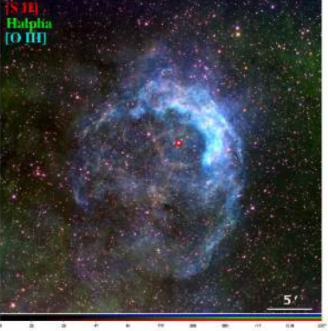
Optical image of NGC 3199. WR 18 is circled in red to the east (left) side of the bright arc.
Credit: Toala et al. 2017
Very massive stars during their lifetime may lose more than half their initial mass through winds. What is left is a hot core known as Wolf-Rayet (WR) star. The discarded outer layers that surround the star are called Wolf-Rayet nebula. Theoretical models predict that these WR nebulae should emit X-rays. These X-rays should be produced as the stellar winds collide with the previously ejected material propagating into the interstellar medium. Nevertheless, this X-ray emission has proved elusive. Now astrophysicists, using the XMM-Newton satellite, detected for the first time this X-ray emission from a Wolf-Rayet (WR) nebula.
The team of astronomers, observed the properties of the area surrounding a WR star, named WR 18 that is associated with the emission nebula NGC 3199. Fig. 1 presents the bright arc of the emission nebula around WR 18. Their analysis revealed that the material nearest the optically bright arc is enriched in metals from strong stellar winds while the material opposite the arc appears to be a mixture of the stellar outflow and the interstellar medium. This implies that the nebular material of NGC 3199 is being actively enriched by the stellar winds from WR 18. The authors suggest that the bright arc is the result of the interaction of the star’s stellar winds with the dense region of the interstellar medium.
Future X-ray observations of WR nebulae can help us understand the physical processes that enrich the interstellar medium and how the interstellar medium can shape the outflows of these stars.
Publication: Toala et al. 2017
Source: AAS NOVA
